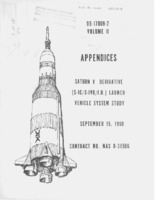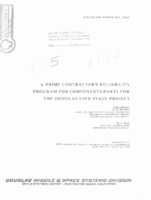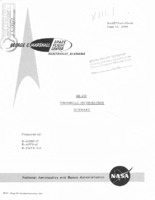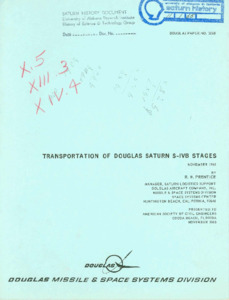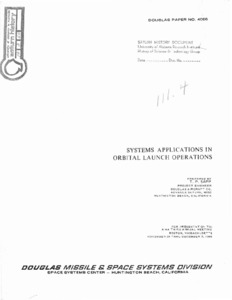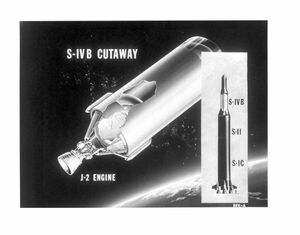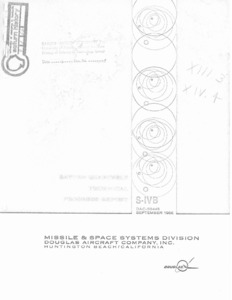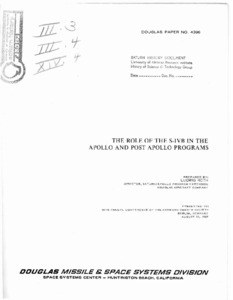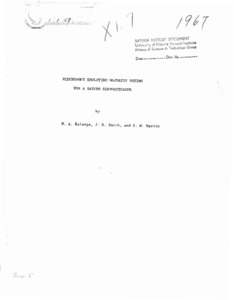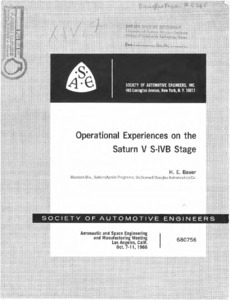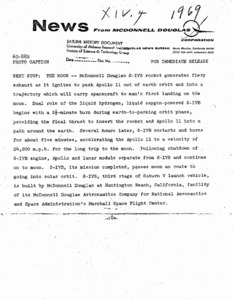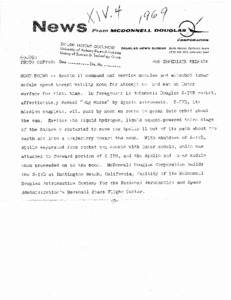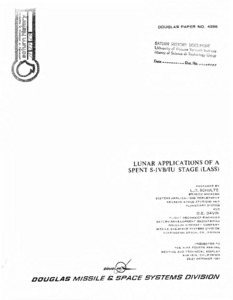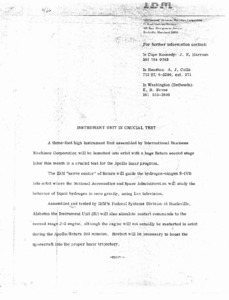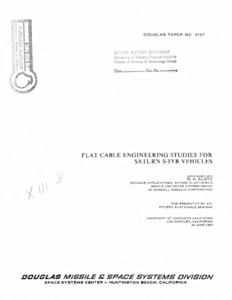
Browse Items (16 total)
Sort by:
-
Volume II Appendices for the Saturn V Derivative Launch Vehicle System Study.
According to the table of contents, this volume of appendices contain various charts, graphs, and diagrams related to the S-IC stage data, instrument unit data, and vehicle data. -
"A Prime Contractor's Reliability Program for Components/Parts for the Douglas S-IVB Stage Project."
This paper, presented at the fifth annual Reliability and Maintainability Conference in New York City, contains a "prime contractor's reliability program for components/parts for the Douglas S-IVB stage project." These parts include special flight critical items and their complementary reliability engineering program plan is outlined in this paper. -
"AS-203 Technical Information Summary."
"This report outlines, through a series of sketches with accompanying text, the general features of the SA-203 Launch Vehicle and information on launch preparation, the launch facility and mission peculiar experiments." -
"Transportation of Douglas Saturn S-IVB stages."
Presented to the American Society of Civil Engineers by R. W. Prentice, manager, Saturn Logistics Support, Douglas Aircraft Company Inc., Missile & Space Systems Division, Space Systems Center, Huntington Beach, California. This paper describes the significant events and equipment associated with transporting the Douglas Aircraft Company, Inc., built Saturn S-IVB stage from stage fabrication at Huntington Beach, California, to the Sacramento Test Center and to the Kennedy Space Center. Descriptions and illustrations of the transportation vehicles and major ground support and instrumentation equipment are presented for a more comprehensive understanding of the transportation problem. -
"The development of a bonded common bulkhead for Saturn."
A Part of the development of the Saturn S-IV/S-IVB stage the Douglas Aircraft Company has pioneered in the development of the cryogenic common bulkhead. The term common bulkhead is derived from the design function of the bulkhead, which is to separate the two cryogenics, liquid hydrogen and liquid oxygen, in a single tank, thereby shortening the stage and eliminating the necessity for two separate bulkheads and the associated interstage structure. The common bulkhead is structurally adequate to withstand both the thermal and the pressure loads from both the hydrogen and the oxygen tanks, and it has sufficient insulation properties to prevent the liquid hydrogen from freezing the liquid oxygen. Another benefit from the common bulkhead is that it permits a reduction in the total length of the vehicle, thereby reducing the bending moments. -
"Systems applications in orbital launch operations."
The objective is to examine the technical requirements and feasibility of conducting orbital launch operations with systems now in the development phase. In order to maintain realistic constraints on the analysis, the Saturn S-IVB stage has been used as an example of present stage technology. The requirements, procedures and complexity of operations for orbital assembly and launch are discussed. The primary design requirement for orbital assembly and launch operations is increased orbital stay time (from hours to days or weeks). -
S-IVB cutaway and J-2 engine."
8 x 10 inch black and white diagram of the JII engine and the Saturn IV. -
"Saturn S-IVB quarterly technical progress report."
Douglas Aircraft Company Report DAC-56445, Saturn S-IVB Quarterly Technical Progress Report, covers design and development progress on the Saturn IB and Saturn V configurations of the S-IVB stage during August and September 1966. This report is prepared for the National Aeronautics and Space Administration under Contract NAS7-101. -
"The role of the S-IVB in the Apollo and past Apollo programs."
Douglas Paper No. 4396.; Prepared by Ludwig Roth, Director, Saturn/Apollo Program Extension, Douglas Aircraft Company.; Presented to 16th Annual Conference of the Hermann Oberth Society. Discusses the role of the Apollo rocket after the Apollo program has concluded. -
"Redundancy employing majority voting for a Saturn servoactuator."
R-ASTR-NF.; ABSTRACT: The servoactuator was developed to improve the reliability of the Saturn S-IVB thrust vector control system by insuring continued system operation if single point failures occur. The selection of the majority voting technique is discussed. Its simplicity is cited along with the advantages of minimum weight, size, power consumption, and compatibility with existing control electronics. Operational features, design mechanization, and the analysis of test results are covered. -
"Operational Experiences on the Saturn V S-IVB stage."
This paper presents a light, but reverent, discussion of some of the Douglas operational experiences on the Saturn V/S-IVB stage. Certain relevant aspects of earlier work on the Thor intermediate range ballistic missile, the Saturn I S-IV stage, and the Uprated Saturn I S-IVB stage are also discussed.; Aeronautic and Space Engineering and Manufacturing Meeting, Los Angeles, Calif., Oct. 7 - 11, 1968. -
"Next stop : the moon."
Release describing the launch of the Apollo 11. -
"Moon-bound"
Press release describing a photograph of a lunar module. -
"Lunar Applications of a Spent S-IVB/IU stage (LASS)."
Support of lunar exploration missions is a major consideration in future space program planning. The spent Saturn v/S-IVB/IU can support both lunar - orbit and lunar -landing operations. This paper investigates lunar applications of the spent stage, and incorporates data generated during Company-funded studies. Investigated here is the feasibility of using a launch vehicle employing standard S-IC and S-I1 boost stages to deliver a modified S-IVB/IU and large discretionary payloads to a lunar orbit (LASSO) and/or the lunar surface (LASS). Operations in Earth orbit and direct-ascent trajectories are examined, and consideration is given to the use of the spent stage as a shelter in a manner similar to the presently planned Earth orbital workshop operations. Both the LASSO and LASS concepts are recommended for consideration in future lunar exploration plans. These concepts are capable of placing a gross wet weight of 101,400 lb in lunar orbit or landing 63,580 lb on the lunar surface respectively. The effective payload capability can be enhanced by proper integration of translunar mission subsystems with the subsystems required for lunar orbit or surface operations. The vehicles can be available within 3 years, with current-technology hardware sufficient for performing the missions described.; Douglas Paper No. 4256. -
"Instrument Unit in Crucial Test."
A three-foot high Instrument tional Business Machines Corporation will be launched into orbit with a huge Saturn second stage
later this month in a crucial test for the Apollo lunar program. -
"Flat Cable Engineering Studies for Saturn S-IVB Vehicles."
This paper describes the engineering approaches, investigations, results and conclusions of two National Aeronautics and Space Administration (NASA) flat-cable contracts from the George C. Marshall Space Flight Center (MSFC) to the Douglas Aircraft Company, Inc., for feasibility studies on the S-IVB stage of the Saturn Vehicle. In addition, the objectives and approaches for a third contract., "Flat-Cable Engineering Study", are discussed. A sister Douglas Paper No. 4186, to be presented by Dr. P. L. Hill, covers in detail the manufacturing aspects of the Flat-Cable Development Program.; Prepared by R.A. Klotz, Advance applications, Saturn Electronics, Missile and Space Systems Group, McDonnell Douglas Corporation for presentation at: IPC/EDN Flat-Cable Seminar, University of Southern California, Los Angeles, California, 20 June 1967.
